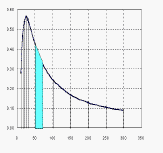

Numerical Methods
for Calculus & DE
 |
MA3457/CS4033 Project # 4: Initial Value Problem |
|---|
 Sections B01/B01
Sections B01/B01
 Mon, Tue, Thu, Fri - 2:00 pm
Mon, Tue, Thu, Fri - 2:00 pm| Basics: |
|---|
The purpose of this project is to apply the methods of numerical solution of initial value problems to practical/real life scenarios.
The numerical techniques to be used in the project: Euler's method, Taylor's method, the Runge-Kutta methods of the 2nd and 4th order.
| Part 1: |
|---|
Problem 1
Background: In the beginning of the XIX century, Robert Malthus suggested a mathematical model of population growth. The model assumed the death rate to be proportional to the size of population, was based on the differential equation y' = ky, and thus led to a pure exponential solution. It has been proven that this model is wrong for human populations, and the logistic function developed by P.F. Verhulst in 1838 was accepted instead as more adequate. The logistic model takes into account aspects involved in the population growth that are not limited to death by natural cause (like environmental factors and others) and therefore is associated with a different differential equation y' = ky(L - y), where L is a constant responsible for everything what may limit the growth of the given population.
The logistic model is applicable to a number of other processes including the spread of disease and information propagation among a given community. In these cases, y represents the number of individuals in the population/group that are infected/having the information and L is the constant size of the considered group.
The resulting logistic curve is obtained as the solution if the initial condition y(0) < L. The behavior of the logistic function is very sensitive with respect to the value of the coefficient k and the constant L.
Data: An initiative group of 10 students wants to organize a concert of a famous rock band on campus to celebrate the upcoming graduation. While holding negotiations with the band's manager, they want to keep the preparation in secret from other 2,000 students. However, the rumor about the planned festivity starts spreading...
Questions:
Problem 2
Background: If water is drained from a vertical cylindrical tank by opening a valve at the base, the water flows fast when the tank is full and slows down as it continues to drain. The rate at which the water level drops is y' = - ksqrt(y), where k is a constant depending on the shape of the hole and the cross-sectional area of the tank and the drain hole.
Data and Question: Engineers building the amusement facility in the aqua-park work with the tank in which the initial level of water is 9 ft. They wish to design the valve which would allow to drain the tank for exactly 60 min. What they need to know is k; then the geometry of the hole could be easily calculated. From the preliminary experiments, it is known that this coefficient should be between 0.05 and 0.15. Use the related numerical methods to determine the optimal k for the engineers.
| Part 2: |
|---|
Problem from Your Field
Background, Data, Question
Course Information | Homework Assignments | Mini Projects | Test Preview | Announcements & Hints